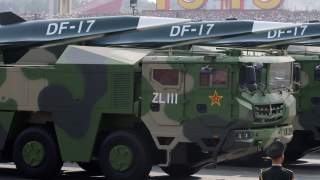Is China’s DF-17 Hypersonic Missile Really a Super-Weapon?
China’s new DF-17 hypersonic missile could penetrate U.S. missile-defense and destroy ports and air-defense systems, a Hong Kong newspaper warned.
China’s new DF-17 hypersonic missile could penetrate U.S. missile-defense and destroy ports and air-defense systems, a Hong Kong newspaper warned.
The new boost-glide missile, which reportedly can travel faster than five times the speed of sound, could “transform” Beijing’s strategy for dealing with Taiwan, South China Morning Post reported.
But one American expert cautioned against assigning profound new capabilities to unproven hypersonic weapons.
The DF-17 first appeared in public in Beijing during a military parade celebrating the 70th anniversary of the founding of Communist China. “Observers were surprised to see 16 DF-17s on their launchers during the Oct. 1, [2019] National Day parade,” South China Morning Post reported.
The DF-17 is a two-stage weapon with a rocket booster and a high-speed gliding warhead. The DF-17 reportedly can strike targets over a distance of nearly a thousand miles. Its speed and flat trajectory could complicate interception attempts. Traditional ballistic missiles such as the DF-15 and DF-16 arc higher than the DF-17 does, making them easier to destroy mid-flight.
Hong Kong-based military expert Song Zhongping told South China Morning Post that the DF-17 could penetrated the U.S.-made missile shields in the region, including Patriot Advanced Capability-3 systems in Taiwan and Terminal High Altitude Area Defense systems in South Korea.
“All the DF-15, DF-16 and DF-17s could build a comprehensive strike network covering everywhere from Taiwan island to the neighbouring countries around mainland China, especially the U.S.’s overseas military bases in the region,” Song said.
“The superiority of the DF-17 is its hypersonic warhead which could penetrate missile-defense networks, radar and early-warning systems, and hit some difficult targets that the DF-15 and DF-16 might be unable to do.”
But David Larter in a November 2019 column in Defense News cautioned against assuming the DF-17 and other hypersonic missiles really are transformative. “The catch is that none of this stuff works yet,” Larter wrote. “I want to emphasize that all of what we’re talking about here are prototypes.”
The United States is developing its own hypersonic missiles and aims to deploy them in the early 2020s.
China first tested the DF-17 in 2013 and rushed the weapon into service. It’s unclear how many of the missiles China possesses and how it plans to use the missiles during wartime. Most importantly, it’s not obvious that China has built a sensor network capable of selecting targets for the DF-17.
Larter cited “missile enthusiast” Tom Karako from the Center for Strategic and International Studies in Washington, D.C. Karako “raised the very excellent point that you will likely need airborne sensors to target these things in the future,” Larter explained.
“It’s not just about shooting missiles — you have to have the complete kill chain,” Karako said. “You have to know where they are going to go, and you have to hope your target hasn’t moved since you pulled the trigger.”
Bryan Clark, an analyst at the Center for Strategic and Budgetary Assessments in Washington, D.C., likewise is skeptical of what Larter described as “the hypersonics craze.”
“These boost-glide prompt-strike weapons are really designed to have a strategic effect,” Clark explained.
“There are a small number of weapons, they are really expensive, so you are not going to hit a bunch of targets with them. So even one weapon that’s a hypersonic weapon could still get shot down. You may not be able to generate a bunch of effects with them because they cost so much that you aren’t going to do the thing where you overwhelm the air-defenses and come in from multiple angles with hypersonics because you don’t have enough of them.”
South China Morning Post conceded that the DF-17 isn’t the best weapon for all targets. “The DF-17 could hit the U.S. fleet in Japan’s Yokosuka [naval base] and destroy the THAAD [sites],” an unnamed military insider told the newspaper, “but for now it is unable to hit high-speed moving warships like an American aircraft carrier.”
David Axe serves as Defense Editor of the National Interest. He is the author of the graphic novels War Fix, War Is Boring and Machete Squad.

